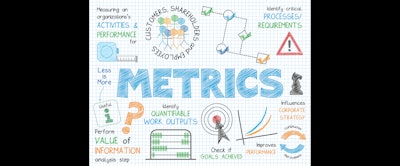
“What gets measured gets done, what gets measured and fed back gets done well, what gets rewarded gets repeated.” — John E. Jones
What percentage of your sales team’s day is spent actively selling? How many sales calls does your team average each day? And what percentage of your sales is coming from new versus returning customers?
Most reps know exactly how many miles they put on their car, or how much money they spent on Dunkin’ Donut gift cards for their customers. What they usually don’t track is how many sales calls they went on last month or their average sales cycle.
After you read this article, you’ll learn the single most important business metric you need to get the absolute best performance out of your sales team.
When identified and leveraged properly, metrics unlock business efficiencies and help define processes that increase the odds of sales success. Conversely, when metrics are poorly chosen and/or improperly utilized, they can result in behaviors that never achieve sustainable, long-term desired outcomes.
All sales organizations use a baseline set of metrics: sales, gross margin, profit dollars, etc. Beyond this rudimentary prerequisite, there is a multitude of more creative metrics that support strategic decision-making. And better-informed decision-making always leads to more consistent, repeatable sales success.
Without Proper Leadership, Metrics Won’t Matter
Too many sales teams are over-managed and under-led. Sales leaders fall into the well-worn rut of relying too much on numbers and deadlines in an effort to drive performance. Successful sales managers consistently find innovative methods to motivate and inspire associates, bringing out the best in everyone and not relying exclusively on just dollars, cents and percentages.
All sales teams thrive in consistent, process-driven environments backed by clearly defined expectations and goals. The more aligned the collective group is behind a common belief and understanding, the more joint success will be realized. Maintaining the same pace of business and collective sense of urgency helps ensure team chemistry, trust and respect. Behind every high-performing sales team is a system of metrics helping guide their collective success.
Effective sales leaders keep their communications concise and their expectations well-defined so sales associates always know exactly what is expected of them. Limit extraneous tasks that detract your sales team from their goal; fewer reports and teleconferences means more time for customer interaction and proactive sales efforts. Strong leaders use metrics to define what behaviors are required and religiously stay in constant communication with their team.
Coach Them Up
Take every advantage — scheduled or unscheduled — to provide one-on-one coaching feedback and inspiration to all members of your team. When you make coaching a high priority it builds team confidence and shows that you care. Inspired coaching results in higher-functioning, more-consistent performers. And when you use metrics to support your coaching methods, you merge the insights data provide with the importance of proper behavioral performance. It’s a powerful combination.
Data shows that companies spend too much time coaching the top 20 percent of the team and trying to improve the bottom 20 percent. Your time is better spent with the middle 60 percent. Invest your finite coaching time with them, leave your top 20 percent alone and work to get rid of the under-performing bottom 20 percent ASAP.
Traditional sales managers default to “spreadsheet coaching” where it’s all about the numbers. When you just focus on the numbers and the quota, you miss the necessary human behaviors that are required to consistently realize the positive outcomes you demand. Lifting weights isn’t about the number of reps, it’s about building strength, flexibility and/or endurance. When you coach by focusing on one key goal, the “reps” will just take care of themselves.
Here’s four of my favorite sales metrics I believe get to the heart of any business:
- The Close Ratio: Close ratio is the number of deals an associate closes compared to the number of contacts they make. If a rep makes 100 calls a year and closes 18 deals, their close ratio is 18 percent. Incremental increases in close ratio typically translate into dramatic increases in revenue and margin. Knowing your team’s close ratio provides statistical line-of-sight to how frequently your team is winning in their efforts and allows you to refocus efforts on behaviors that will work to improve your team’s ratio.
- Sales Cycle: Sales cycle is another often-overlooked metric. Knowing how much time elapses from prospect to paying customer provides valuable insight into the vitality of your sales efforts. The faster you can convert people, the more people you’ll convert. When you know your sales cycle, it makes it easier to predict when sales won’t happen. If a prospect is in the pipeline for 13 weeks and your sales cycle is usually 10 weeks, you’re probably not going to win that business.
- New Vs. Returning Customer Sales: Healthy businesses strike a good balance of new and repeat customers. Getting customers to buy from you again (thus increasing their lifetime value) certainly improves sales and profits. And with the costs of acquiring new customers continuing to escalate, understanding your mix of new and repeat customers can be an important data-point to use to help develop your strategy.
- Revenue Per Sale: One of the easiest strategies to grow both topline and margin is revenue per sale. It’s the proverbial suggestive sell: “You want fries with that?” Adding additional items to a customer’s existing order increases sales and profits while adding negligible, incremental cost. Focus on your revenue per sale and your volume and margin dollars should improve accordingly.
Find Your Focus
With few exceptions, most traditional sales metrics are trailing indicators — they look back and state what happened. When you develop and focus on metrics that measure what is actively happening versus what happened, you stand a much better chance of rapidly (and profitably) growing your business.
So what’s the most important metric to your sales channel-to-market right now? The answer: the one that’s broken. It’s up to you to identify which specific metric in your unique business is paramount to help get you to your sales inflection point. Work diligently to identify it. Then focus relentlessly on that one crucial item, coach up your team, and unleash your success.
 Jeff Guritza, Business Development Manager, M.K. Morse Company
Jeff Guritza, Business Development Manager, M.K. Morse CompanyWhen it comes to leading your sales team, don’t simply manage to metrics. Rather, leverage the power of metrics to better manage your team’s behavior. Properly configured, metrics will reliably ensure that you’re aligned, consistent, predictable and profitable.
Jeff Guritza has used metrics to successfully leverage accounts to an eight percent YOY jump in gross margin. He also used metrics to identify “sweet spots” in pricing that dramatically improved quote close rates. He saved millions of dollars in manufacturing using metrics to analyze and strategically rationalize primary product lines.























